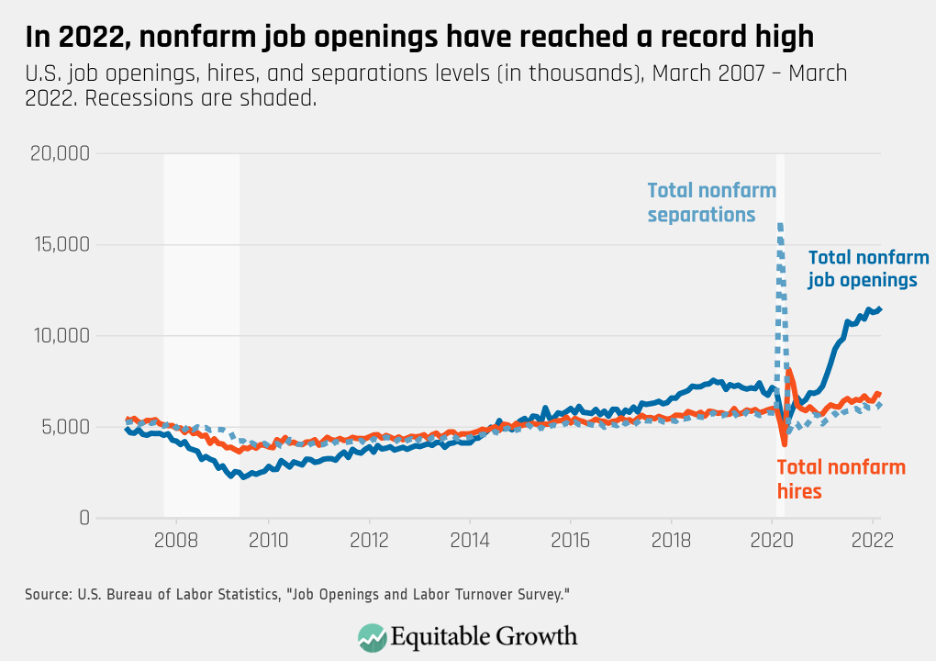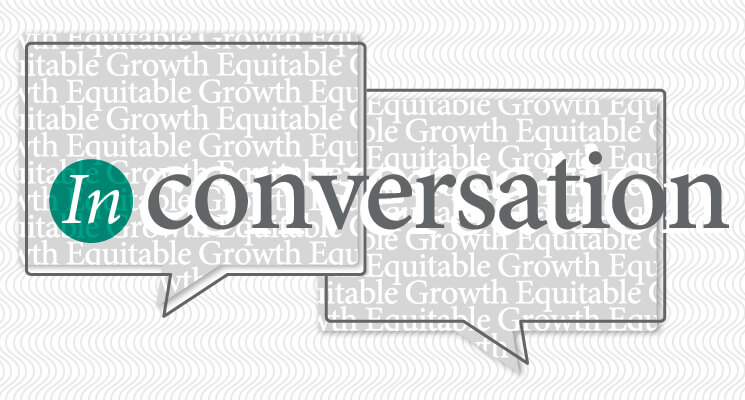Is there a skilled labor shortage? The economic evidence on skills gap and labor shortage concerns

Claims of a “skills gap” or “labor shortage” in the United States are often cited during times of high unemployment as the reason why workers are unable to find jobs and to explain rising wage inequality more broadly. For instance, in the years immediately following the Great Recession of 2007–2009, a skills gap or “mismatch” was often cited as a major reason for the labor market’s slow recovery after the end of that 2-year economic downturn in 2009.
Yet today, with wages for non-college-educated workers on the rise and their unemployment rate falling, there are still reports of a skills shortage preventing employers hiring workers for jobs that do not require a college degree. These vague and often contradictory claims of skilled labor gaps, shortages, and mismatches remain common in industry discussions even though they do not make sense when applied to actual conditions in U.S. labor markets.
When employers have difficulty finding workers to hire at the wages and working conditions offered, viewing this as evidence of a skilled labor shortage lasting years or even decades runs contrary to our understanding of labor market models and years of economic research. So, let’s look at the actual evidence.
What economic evidence can tell us about skills gap and labor shortage concerns
The concept of a skilled labor shortage assumes a static world of unchanging supply and demand, which Peter Cappelli at the University of Pennsylvania’s Wharton School of Management describes as “akin to input–output models associated with operations research optimization exercises,” instead of a dynamic labor market. This framing interprets factors such as wages, job vacancies, and job requirements as fixed and immutable, when these are changing and dynamic aspects of any labor market.
Take job requirements. Research shows that employers often raise requirements during times of high unemployment, leveraging slack in the U.S. labor market to demand higher levels of credentials without commensurate compensation—even though workers without credentials or at different skills levels may be very well able to succeed at those roles.
Indeed, amid the Great Recession and the subsequently slow economic recovery, Alicia Sasser Modestino of Northeastern University, Daniel Shoag of Harvard University, and Joshua Balance of the Federal Reserve Bank of Boston found that higher unemployment alone accounted for up to a quarter of the increase in job skill requirements between 2007 and 2010. The same authors also found evidence of the inverse—“downskilling”—from 2010 to 2014 as the labor market recovered, though many higher requirements remained.
More recently, the Burning Glass Institute found that the share of job postings in the United States requiring degrees or other credentials fell between 2017 and 2019, which continued into the pandemic. In fact, the report found that fewer jobs required a college degree in 2021 than in 2017. The report’s findings suggest that many U.S. employers are using bachelor’s degree requirements as proxies for specific soft skills, such as written or oral communication skills.
Meanwhile, the actual gap—between skills gap narratives and labor market realities—is, unfortunately, not new. In a 2015 article, University of Maryland economist Katharine Abraham showed that policymakers and business groups have diagnosed the labor market with this type of structural skills mismatch during periods of high unemployment following the dot-com crash in the early 2000s, the recession in the early 1980s, and even back to the mid-1960s.
Walking through relevant economic research, Abraham finds no evidence of a structural skills gap, supply-demand mismatch, or labor shortage, despite such shortages being taken “as a given” in industry and policy discussions. Despite this lack of economic evidence, skills gap and labor shortage narratives persist and do real harm to workers and the country’s economic growth. These narratives diagnose companies’ hiring problems as a matter of worker characteristics, despite clear economic evidence to the contrary—even treating rising wages for very low-wage workers as a problem to be solved.
More fundamentally, these “gap” narratives prevent companies and policymakers from identifying and addressing the underlying causes of these companies’ hiring and retention difficulties. Fortunately, they need not look far to understand what’s really happening in U.S. labor markets.
A closer look at acute staffing shortages in U.S. labor markets
While seasonally adjusted job vacancies are at their highest level since the U.S. Bureau of Labor Statistics began reporting this data series in December 2000, hiring is also very strong and above pre-pandemic levels. This strong hiring is taking place in a labor market that is still recovering from the dramatic job losses of March 2020. As Equitable Growth’s chief economist and Labor Market Policy Director Kate Bahn recently explained on NPR’s Planet Money, “as quick as the crisis led to an economic decline, the quick recovery, too, is just going to have some tumultuousness to it because it takes a long time to get workers into good jobs.”
Now, many employers are trying to increase staffing to meet rebounding consumer demand. As a closer look at several industries shows, though, this hiring is taking place on top of the turnover-driven hiring needs that have been exacerbated by the stress and volatility of the past 2 years. (See Figure 1.)
Figure 1

Many of the currently acute staffing shortages are in service jobs in retail and in leisure and hospitality—two volatile, low-wage sectors with many front-line workers and longstanding job-quality issues. The job opening rate in accommodation and food services, in particular, is almost 10 percent. Many workers in these sectors have been changing jobs to obtain higher wages and better working conditions within and between industries, as many did prior to the pandemic.
Hiring difficulties in construction and trucking are also not new, but their renewed urgency in this phase of the current economic recovery highlights how such persistent hiring difficulties are still blamed on skill shortages despite clear market signals that job quality was to blame. Both of those sectors of the U.S. economy could offer relatively higher wages for non-college-educated workers, particularly for mid-career workers onward, but retention for entry-level workers is low due to poor pay and difficult or dangerous working conditions.
Employment levels for many care workers also remain far below pre-pandemic levels. Nursing homes and other long-term care facilities, which are consistently epicenters of the continuing COVID-19 pandemic, continue to experience “critical” staffing shortages as more recent stresses and burnout build on years of persistently low wages, overwork, and poor working conditions. Here, the job-quality issues are also the result of specific market failures, as economists Sandra Black at Columbia University and Jesse Rothstein at the University of California, Berkeley demonstrate, tied to lack of public investment for this consistently undervalued workforce.
Improving job quality in high-turnover industries is key to a full U.S. labor market recovery
In each of the industries outlined above, the evidence is lacking to claim that an absolute shortage of qualified workers is the problem in the U.S. labor market today. Indeed, workers in these industries are choosing to work elsewhere in response to better wages and working conditions on offer. Employer responses such as increasing compensation and offering on-the-job training are, in the words of U-Penn Wharton’s Cappelli, overdue “standard textbook solutions” from a business perspective, which would be expected in a fully functioning labor market.
In fact, this recent rise in wages for many non-college-educated workers underscores a body of research that shows the wage “premium” associated with having a college degree is inextricably tied to declining labor protections and bargaining power for low-wage workers without a degree—not the inherent value of the degree itself. This is why it is crucial to enhance job quality, labor standards, and the ability of workers to organize going forward, so that all workers can be competitively compensated for their education, skills, and experience.
Within the private sector, U.S. employers can reevaluate exclusionary hiring practices, train incumbent workers, and improve job quality to increase retention and reduce turnover costs. To support these efforts, policymakers can improve labor standards, encourage “high-road employment,” and invest in enforcement against bad actors so that high-road employers aren’t disadvantaged in the market.
Evidence also shows that unions reduce income inequality and protect workers. And public investments in health, education, care work, and other vital areas experiencing market failure will also be necessary to improve job quality and meet public need.
Improving wages, benefits, and working conditions can have spillover benefits for consumers and communities as well. A working paper by Equitable Growth grantee Krista Ruffini of Georgetown University finds that minimum wage increases not only improved worker retention at nursing homes but also led to better health and safety practices and reduced deaths among residents.
What’s more, there is accumulating evidence that the challenges employers experience in hiring workers may go beyond individual companies’ willingness to raise wages. The University of Maryland’s Abraham suggests that an alternative explanation for employers’ experiences of hiring challenges is actually a lack of competition in the labor market itself—an imbalance of power economists describe as monopsony, which leads to both lower employment and lower wages than would otherwise exist.
To address this, policymakers should work to make U.S. labor markets more competitive and rebalance the playing field. Raising the minimum wage, supporting worker bargaining power, and strengthening discrimination enforcement are all necessary tools to counteract the distortionary market forces that depress wages and employment.







